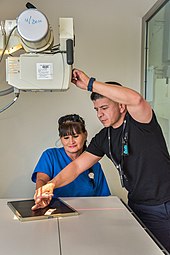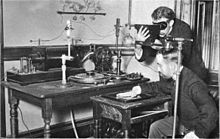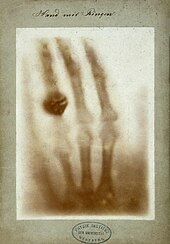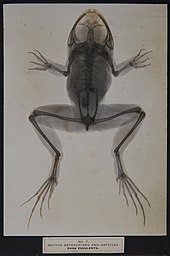Radiography
 Projectional radiographyof the knee in a modern X-ray machine | |
| System | Musculoskeletal |
|---|---|
| Subdivisions | Interventional, Nuclear, Therapeutic, Paediatric |
| Significantdiseases | Cancer,bone fractures |
| Significanttests | screening tests,X-ray,CT,MRI,PET,bone scan,ultrasonography,mammography,fluoroscopy |
| Specialist | Radiographer |
Radiographyis animaging techniqueusingX-rays,gamma rays,or similar ionizing radiation and non-ionizing radiation to view the internal form of an object. Applications of radiography include medical ( "diagnostic" radiography and "therapeutic" ) andindustrial radiography.Similar techniques are used inairport security,(where "body scanners" generally usebackscatter X-ray). To create an image inconventional radiography,a beam of X-rays is produced by anX-ray generatorand it is projected towards the object. A certain amount of the X-rays or other radiation are absorbed by the object, dependent on the object's density and structural composition. The X-rays that pass through the object are captured behind the object by adetector(eitherphotographic filmor a digital detector). The generation of flattwo-dimensionalimages by this technique is calledprojectional radiography.Incomputed tomography(CT scanning), an X-ray source and its associated detectors rotate around the subject, which itself moves through the conical X-ray beam produced. Any given point within the subject is crossed from many directions by many different beams at different times. Information regarding the attenuation of these beams is collated and subjected to computation to generate two-dimensional images on three planes (axial, coronal, and sagittal) which can be further processed to produce a three-dimensional image.

Medical uses
[edit]| Radiography | |
|---|---|
| ICD-9-CM | 87,88.0-88.6 |
| MeSH | D011859 |
| OPS-301 code | 3–10...3–13,3–20...3–26 |
Since the body is made up of various substances with differing densities, ionising and non-ionising radiation can be used to reveal the internal structure of the body on an image receptor by highlighting these differences usingattenuation,or in the case of ionising radiation, the absorption of X-rayphotonsby the denser substances (likecalcium-rich bones). The discipline involving the study of anatomy through the use of radiographic images is known asradiographic anatomy.Medical radiography acquisition is generally carried out byradiographers,while image analysis is generally done byradiologists.Some radiographers also specialise in image interpretation. Medical radiography includes a range of modalities producing many different types of image, each of which has a different clinical application.
Projectional radiography
[edit]
The creation of images by exposing an object toX-raysor other high-energy forms ofelectromagnetic radiationand capturing the resulting remnant beam (or "shadow" ) as a latent image is known as "projection radiography". The "shadow" may be converted to light using a fluorescent screen, which is then captured onphotographic film,it may be captured by a phosphor screen to be "read" later by a laser (CR), or it may directly activate a matrix ofsolid-statedetectors (DR—similar to a very large version of aCCDin a digital camera).Boneand some organs (such aslungs) especially lend themselves to projection radiography. It is a relatively low-cost investigation with a highdiagnosticyield. The difference betweensoftandhardbody parts stems mostly from the fact that carbon has a very low X-ray cross section compared to calcium.
Computed tomography
[edit]
Computed tomographyor CT scan (previously known as CAT scan, the "A" standing for "axial" ) uses ionizing radiation (x-ray radiation) in conjunction with a computer to create images of both soft and hard tissues. These images look as though the patient was sliced like bread (thus, "tomography" – "tomo" means "slice" ). Though CT uses a higher amount of ionizing x-radiation than diagnostic x-rays (both utilising X-ray radiation), with advances in technology, levels of CT radiation dose and scan times have reduced.[1]CT exams are generally short, most lasting only as long as a breath-hold,Contrast agentsare also often used, depending on the tissues needing to be seen. Radiographers perform these examinations, sometimes in conjunction with a radiologist (for instance, when a radiologist performs a CT-guidedbiopsy).
Dual energy X-ray absorptiometry
[edit]DEXA,or bone densitometry, is used primarily forosteoporosistests. It is not projection radiography, as the X-rays are emitted in two narrow beams that are scanned across the patient, 90 degrees from each other. Usually the hip (head of thefemur), lower back (lumbar spine), or heel (calcaneum) are imaged, and the bone density (amount of calcium) is determined and given a number (a T-score). It is not used for bone imaging, as the image quality is not good enough to make an accurate diagnostic image for fractures, inflammation, etc. It can also be used to measure total body fat, though this is not common. The radiation dose received from DEXA scans is very low, much lower than projection radiography examinations.[citation needed]
Fluoroscopy
[edit]Fluoroscopy is a term invented by Thomas Edison during his early X-ray studies. The name refers to the fluorescence he saw while looking at a glowing plate bombarded with X-rays.[2]
The technique provides moving projection radiographs. Fluoroscopy is mainly performed to view movement (of tissue or a contrast agent), or to guide a medical intervention, such as angioplasty, pacemaker insertion, or joint repair/replacement. The last can often be carried out in the operating theatre, using a portable fluoroscopy machine called a C-arm.[3]It can move around the surgery table and make digital images for the surgeon. Biplanar Fluoroscopy works the same as single plane fluoroscopy except displaying two planes at the same time. The ability to work in two planes is important for orthopedic and spinal surgery and can reduce operating times by eliminating re-positioning.[4]
Angiography
[edit]
Angiographyis the use of fluoroscopy to view the cardiovascular system. An iodine-based contrast is injected into the bloodstream and watched as it travels around. Since liquid blood and the vessels are not very dense, a contrast with high density (like the large iodine atoms) is used to view the vessels under X-ray. Angiography is used to findaneurysms,leaks, blockages (thromboses), new vessel growth, and placement of catheters and stents.Balloon angioplastyis often done with angiography.
Contrast radiography
[edit]Contrast radiography uses a radiocontrast agent, a type ofcontrast medium,to make the structures of interest stand out visually from their background. Contrast agents are required in conventionalangiography,and can be used in bothprojectional radiographyandcomputed tomography(calledcontrast CT).[5][6]
Other medical imaging
[edit]Although not technically radiographic techniques due to not using X-rays, imaging modalities such asPETandMRIare sometimes grouped in radiography because theradiologydepartment of hospitals handle all forms ofimaging.Treatment using radiation is known asradiotherapy.
Industrial radiography
[edit]Industrial radiographyis a method ofnon-destructive testingwhere many types of manufactured components can be examined to verify the internal structure and integrity of the specimen. Industrial Radiography can be performed utilizing eitherX-raysorgamma rays.Both are forms ofelectromagnetic radiation.The difference between various forms of electromagnetic energy is related to thewavelength.X and gamma rays have the shortest wavelength and this property leads to the ability to penetrate, travel through, and exit various materials such ascarbon steeland other metals. Specific methods includeindustrial computed tomography.

Image quality
[edit]Image quality will depend on resolution and density. Resolution is the ability an image to show closely spaced structure in the object as separate entities in the image while density is the blackening power of the image. Sharpness of a radiographic image is strongly determined by the size of the X-ray source. This is determined by the area of the electron beam hitting the anode. A large photon source results in more blurring in the final image and is worsened by an increase in image formation distance. This blurring can be measured as a contribution to themodulation transfer functionof the imaging system.
Radiation dose
[edit]The dosage of radiation applied in radiography varies by procedure. For example, the effective dosage of a chest x-ray is 0.1 mSv, while an abdominal CT is 10 mSv.[7]TheAmerican Association of Physicists in Medicine(AAPM) have stated that the "risks of medical imaging at patient doses below 50 mSv for single procedures or 100 mSv for multiple procedures over short time periods are too low to be detectable and may be nonexistent." Other scientific bodies sharing this conclusion include theInternational Organization of Medical Physicists,theUN Scientific Committee on the Effects of Atomic Radiation,and theInternational Commission on Radiological Protection.Nonetheless, radiological organizations, including theRadiological Society of North America(RSNA) and theAmerican College of Radiology(ACR), as well as multiple government agencies, indicate safety standards to ensure that radiation dosage is as low as possible.[8]
Shielding
[edit]| X-rays generated by peak voltages below |
Minimum thickness of lead |
|---|---|
| 75 kV | 1.0 mm |
| 100 kV | 1.5 mm |
| 125 kV | 2.0 mm |
| 150 kV | 2.5 mm |
| 175 kV | 3.0 mm |
| 200 kV | 4.0 mm |
| 225 kV | 5.0 mm |
| 300 kV | 9.0 mm |
| 400 kV | 15.0 mm |
| 500 kV | 22.0 mm |
| 600 kV | 34.0 mm |
| 900 kV | 51.0 mm |
Leadis the most common shield against X-rays because of its high density (11,340 kg/m3), stopping power, ease of installation and low cost. The maximum range of a high-energy photon such as an X-ray in matter is infinite; at every point in the matter traversed by the photon, there is a probability of interaction. Thus there is a very small probability of no interaction over very large distances. The shielding of photon beam is therefore exponential (with anattenuation lengthbeing close to theradiation lengthof the material); doubling the thickness of shielding will square the shielding effect.
Table in this section shows the recommended thickness of lead shielding in function of X-ray energy, from the Recommendations by the Second International Congress of Radiology.[9]
Campaigns
[edit]In response to increased concern by the public over radiation doses and the ongoing progress of best practices, The Alliance for Radiation Safety in Pediatric Imaging was formed within theSociety for Pediatric Radiology.In concert with theAmerican Society of Radiologic Technologists,theAmerican College of Radiology,and theAmerican Association of Physicists in Medicine,the Society for Pediatric Radiology developed and launched the Image Gently campaign which is designed to maintain high quality imaging studies while using the lowest doses and best radiation safety practices available on pediatric patients.[10]This initiative has been endorsed and applied by a growing list of various professional medical organizations around the world and has received support and assistance from companies that manufacture equipment used in radiology.
Following upon the success of the Image Gently campaign, the American College of Radiology, the Radiological Society of North America, the American Association of Physicists in Medicine, and the American Society of Radiologic Technologists have launched a similar campaign to address this issue in the adult population called Image Wisely.[11]TheWorld Health OrganizationandInternational Atomic Energy Agency(IAEA) of the United Nations have also been working in this area and have ongoing projects designed to broaden best practices and lower patient radiation dose.[12][13][14]
Provider payment
[edit]Contrary to advice that emphasises only conducting radiographs when in the patient's interest, recent evidence suggests that they are used more frequently when dentists are paid under fee-for-service.[15]
Equipment
[edit]


Sources
[edit]In medicine and dentistry,projectional radiographyandcomputed tomography imagesgenerally use X-rays created byX-ray generators,which generate X-rays fromX-ray tubes.The resultant images from the radiograph (X-ray generator/machine) or CT scanner are correctly referred to as "radiograms" / "roentgenograms" and "tomograms" respectively.
A number of other sources ofX-rayphotonsare possible, and may be used in industrial radiography or research; these includebetatrons,linear accelerators(linacs), andsynchrotrons.Forgamma rays,radioactivesources such as192Ir,60Co,or137Csare used.
Grid
[edit]Ananti-scatter gridmay be placed between the patient and the detector to reduce the quantity of scattered x-rays that reach the detector. This improves the contrast resolution of the image, but also increases radiation exposure for the patient.[16]
Detectors
[edit]Detectors can be divided into two major categories: imaging detectors (such asphotographic platesand X-ray film (photographic film), now mostly replaced by variousdigitizingdevices likeimage platesorflat panel detectors) and dose measurement devices (such asionization chambers,Geiger counters,anddosimetersused to measure the localradiation exposure,dose,and/or dose rate, for example, for verifying thatradiation protectionequipment and procedures are effective on an ongoing basis).[17][18][19]
Side markers
[edit]A radiopaque anatomical side marker is added to each image. For example, if the patient has their right hand x-rayed, the radiographer includes a radiopaque "R" marker within the field of the x-ray beam as an indicator of which hand has been imaged. If a physical marker is not included, the radiographer may add the correct side marker later as part of digital post-processing.[20]
Image intensifiers and array detectors
[edit]As an alternative to X-ray detectors,image intensifiersare analog devices that readily convert the acquired X-ray image into one visible on a video screen. This device is made of a vacuum tube with a wide input surface coated on the inside withcaesium iodide(CsI). When hit by X-rays material phosphors which causes thephotocathodeadjacent to it to emit electrons. These electrons are then focused using electron lenses inside the intensifier to an output screen coated with phosphorescent materials. The image from the output can then be recorded via a camera and displayed.[21]
Digital devices known as array detectors are becoming more common in fluoroscopy. These devices are made of discrete pixelated detectors known asthin-film transistors(TFT) which can either workindirectlyby using photo detectors that detect light emitted from a scintillator material such as CsI, ordirectlyby capturing the electrons produced when the X-rays hit the detector. Direct detectors do not tend to experience the blurring or spreading effect caused by phosphorescent scintillators or by film screens since the detectors are activated directly by X-ray photons.[22]
Dual-energy
[edit]Dual-energyradiographyis where images are acquired using two separatetube voltages.This is the standard method forbone densitometry.It is also used inCT pulmonary angiographyto decrease the required dose ofiodinated contrast.[23]
History
[edit]
Radiography's origins andfluoroscopy's originscan both be traced to 8 November 1895, when German physics professorWilhelm Conrad Röntgendiscovered the X-ray and noted that, while it could pass through human tissue, it could not pass through bone or metal.[24]Röntgen referred to the radiation as "X", to indicate that it was an unknown type of radiation. He received the firstNobel Prize in Physicsfor his discovery.[25]
There are conflicting accounts of his discovery because Röntgen had his lab notes burned after his death, but this is a likely reconstruction by his biographers:[26][27]Röntgen was investigatingcathode raysusing afluorescentscreen painted with bariumplatinocyanideand aCrookes tubewhich he had wrapped in black cardboard to shield its fluorescent glow. He noticed a faint green glow from the screen, about 1 metre away. Röntgen realized some invisible rays coming from the tube were passing through the cardboard to make the screen glow: they were passing through an opaque object to affect the film behind it.[28]

Röntgen discovered X-rays' medical use when he made a picture of his wife's hand on a photographic plate formed due to X-rays. The photograph of his wife's hand was the first ever photograph of a human body part using X-rays. When she saw the picture, she said, "I have seen my death."[28]
The first use of X-rays under clinical conditions was byJohn Hall-EdwardsinBirmingham, England,on 11 January 1896, when he radiographed a needle stuck in the hand of an associate. On 14 February 1896, Hall-Edwards also became the first to use X-rays in a surgical operation.[29]
The United States saw its first medical X-ray obtained using adischarge tubeofIvan Pulyui's design. In January 1896, on reading of Röntgen's discovery, Frank Austin ofDartmouth Collegetested all of the discharge tubes in the physics laboratory and found that only the Pulyui tube produced X-rays. This was a result of Pulyui's inclusion of an oblique "target" ofmica,used for holding samples offluorescentmaterial, within the tube. On 3 February 1896 Gilman Frost, professor of medicine at the college, and his brother Edwin Frost, professor of physics, exposed the wrist of Eddie McCarthy, whom Gilman had treated some weeks earlier for a fracture, to the X-rays and collected the resulting image of the broken bone ongelatin photographic platesobtained from Howard Langill, a local photographer also interested in Röntgen's work.[30]

X-rays were put to diagnostic use very early; for example,Alan Archibald Campbell-Swintonopened a radiographic laboratory in the United Kingdom in 1896, before the dangers of ionizing radiation were discovered. Indeed,Marie Curiepushed for radiography to be used to treat wounded soldiers in World War I. Initially, many kinds of staff conducted radiography in hospitals, including physicists, photographers, physicians, nurses, and engineers. The medical speciality of radiology grew up over many years around the new technology. When new diagnostic tests were developed, it was natural for theradiographersto be trained in and to adopt this new technology. Radiographers now performfluoroscopy,computed tomography,mammography,ultrasound,nuclear medicineandmagnetic resonance imagingas well. Although a nonspecialist dictionary might define radiography quite narrowly as "taking X-ray images", this has long been only part of the work of "X-ray departments", radiographers, and radiologists. Initially, radiographs were known as roentgenograms,[31]whileskiagrapher(from theAncient Greekwords for "shadow" and "writer" ) was used until about 1918 to meanradiographer.The Japanese term for the radiograph,rentogen(レントゲン),shares its etymology with the original English term.
See also
[edit]- Autoradiograph
- Background radiation
- Computer-aided diagnosis
- GXMO
- Imaging science
- List of civilian radiation accidents
- Medical imaging in pregnancy
- Radiation
- Digital radiography
- Radiation contamination
- Radiographer
- Thermography
References
[edit]- ^Jang J, Jung SE, Jeong WK, Lim YS, Choi JI, Park MY, et al. (February 2016)."Radiation Doses of Various CT Protocols: a Multicenter Longitudinal Observation Study".Journal of Korean Medical Science.31(Suppl 1): S24-31.doi:10.3346/jkms.2016.31.S1.S24.PMC4756338.PMID26908984.
- ^Carroll QB (2014).Radiography in the Digital Age(2nd ed.). Springfield: Charles C Thomas. p. 9.ISBN9780398080976.
- ^Seeram E, Brennan PC (2016).Radiation Protection in Diagnostic X-Ray Imaging.Jones & Bartlett.ISBN9781284117714.
- ^Schueler BA (July 2000). "The AAPM/RSNA physics tutorial for residents: general overview of fluoroscopic imaging".Radiographics.20(4): 1115–26.doi:10.1148/radiographics.20.4.g00jl301115.PMID10903700.
- ^Quader MA, Sawmiller CJ, Sumpio BE (2000). "Radio Contrast Agents: History and Evolution".Textbook of Angiology.pp. 775–783.doi:10.1007/978-1-4612-1190-7_63.ISBN978-1-4612-7039-3.
- ^Brant WE, Helms CA (2007)."Diagnostic Imaging Methods".Fundamentals of Diagnostic Radiology(3rd ed.). Philadelphia: Lippincott Williams & Wilkins. p. 3.ISBN9780781761352.
- ^"Reducing Radiation from Medical X-rays".FDA.gov.Retrieved9 September2018.
- ^Goldberg J (September–October 2018). "From the Spectral to the Spectrum".Skeptical Inquirer.42(5).
- ^Alchemy Art Lead Products –Lead Shielding Sheet Lead For Shielding Applications.Retrieved 7 December 2008.
- ^"IG new: The Alliance | image gently".Pedrad.org. Archived fromthe originalon 9 June 2013.Retrieved16 August2013.
- ^"Radiation Safety in Adult Medical Imaging".Image Wisely.Retrieved16 August2013.
- ^"Optimal levels of radiation for patients – Pan American Health Organization – Organización Panamericana de la Salud".New.paho.org. 24 August 2010. Archived fromthe originalon 25 May 2013.Retrieved16 August2013.
- ^"Radiation Protection of Patients".Rpop.iaea.org. 14 March 2013.Retrieved16 August2013.
- ^"World Health Organisation: Global Initiative on Radiation Safety in Healthcare Settings: Technical Meeting Report"(PDF).Who.int.Archived(PDF)from the original on 29 October 2013.Retrieved16 August2013.
- ^Chalkley M, Listl S (March 2018)."First do no harm - The impact of financial incentives on dental X-rays".Journal of Health Economics.58(March 2018): 1–9.doi:10.1016/j.jhealeco.2017.12.005.hdl:2066/190628.PMID29408150.
- ^Bushberg JT (2002).The Essential Physics of Medical Imaging(2nd ed.). Philadelphia: Lippincott Williams & Wilkins. p. 210.ISBN9780683301182.
- ^Ranger NT (1999). "Radiation detectors in nuclear medicine".Radiographics.19(2): 481–502.doi:10.1148/radiographics.19.2.g99mr30481.PMID10194791.
- ^DeWerd LA, Wagner LK (January 1999). "Characteristics of radiation detectors for diagnostic radiology".Applied Radiation and Isotopes.50(1): 125–36.doi:10.1016/S0969-8043(98)00044-X.PMID10028632.
- ^Anwar K (2013). "Nuclear Radiation Detectors".Particle Physics.Graduate Texts in Physics. Berlin: Springer-Verlag. pp. 1–78.doi:10.1007/978-3-642-38661-9_1.ISBN978-3-642-38660-2.
- ^Barry K, Kumar S, Linke R, Dawes E (September 2016)."A clinical audit of anatomical side marker use in a paediatric medical imaging department".Journal of Medical Radiation Sciences.63(3): 148–54.doi:10.1002/jmrs.176.PMC5016612.PMID27648278.
- ^Hendee WR, Ritenour ER (2002)."Fluoroscopy".Medical Imaging Physics(4th ed.). Hoboken, NJ: John Wiley & Sons.ISBN9780471461135.
- ^Seibert JA (September 2006)."Flat-panel detectors: how much better are they?".Pediatric Radiology.36 Suppl 2 (S2): 173–81.doi:10.1007/s00247-006-0208-0.PMC2663651.PMID16862412.
- ^Cochrane Miller J (2015)."Dual Energy CT Imaging for Suspected Pulmonary Embolism Using a Lower Dose of Contrast Agent".Radiology Rounds.13(7). Archived fromthe originalon 10 May 2017.Retrieved5 February2018.
- ^"History of Radiography".NDT Resource Center.Iowa State University.Retrieved27 April2013.
- ^Karlsson EB (9 February 2000)."The Nobel Prizes in Physics 1901–2000".Stockholm: The Nobel Foundation.Retrieved24 November2011.
- ^"5 unbelievable things about X-rays you can't miss".vix.com.Archived fromthe originalon 24 December 2020.Retrieved23 October2017.
- ^Glasser O (1993).Wilhelm Conrad Röntgen and the early history of the roentgen rays.Norman Publishing. pp. 10–15.ISBN978-0930405229.
- ^abMarkel H (20 December 2012)."'I Have Seen My Death': How the World Discovered the X-Ray ".PBS NewsHour.PBS. Archived fromthe originalon 20 August 2020.Retrieved27 April2013.
- ^"Major John Hall-Edwards".Birmingham City Council. Archived fromthe originalon 28 September 2012.Retrieved17 May2012.
- ^Spiegel PK (January 1995)."The first clinical X-ray made in America – 100 years".American Journal of Roentgenology.164(1). American Roentgen Ray Society: 241–3.doi:10.2214/ajr.164.1.7998549.PMID7998549.
- ^Ritchey B, Orban B (April 1953). "The Crests of the Interdental Alveolar Septa".The Journal of Periodontology.24(2): 75–87.doi:10.1902/jop.1953.24.2.75.
Further reading
[edit]- Oakley, PA; Harrison, DE (2020). X-Ray Hesitancy: Patients' Radiophobic Concerns Over Medical X-rays. Dose-Response.Specific Safety Guide No. SSG-11(Report). Vienna: International Atomic Energy Agency.doi:10.1177/1559325820959542.PMC7503016.
- Seliger HH (November 1995)."Wilhelm Conrad Röntgen and the Glimmer of Light".Physics Today.48(11): 25–31.Bibcode:1995PhT....48k..25S.doi:10.1063/1.881456.hdl:10013/epic.43596.d001.
- Shroy Jr RE (1995). "X-Ray equipment". In Bronzino JD (ed.).The Biomedical Engineering handbook.CRC Press and IEEE Press. pp. 953–960.ISBN978-0-8493-8346-5.
- Herman GT(2009).Fundamentals of Computerized Tomography: Image Reconstruction from Projections(2nd ed.). Springer.ISBN978-1-85233-617-2.
- Yu SB, Watson AD (September 1999). "Metal-Based X-ray Contrast Media".Chemical Reviews.99(9): 2353–78.doi:10.1021/cr980441p.PMID11749484.
External links
[edit]- MedPixMedical Image Database
- Video on X-ray inspection and industrial computed tomography,Karlsruhe University of Applied Sciences
- NIST's XAAMDI: X-Ray Attenuation and Absorption for Materials of Dosimetric Interest Database
- NIST's XCOM: Photon Cross Sections Database
- NIST's FAST: Attenuation and Scattering Tables
- A lost industrial radiography source event
- RadiologyInfo -The radiology information resource for patients: Radiography (X-rays)
